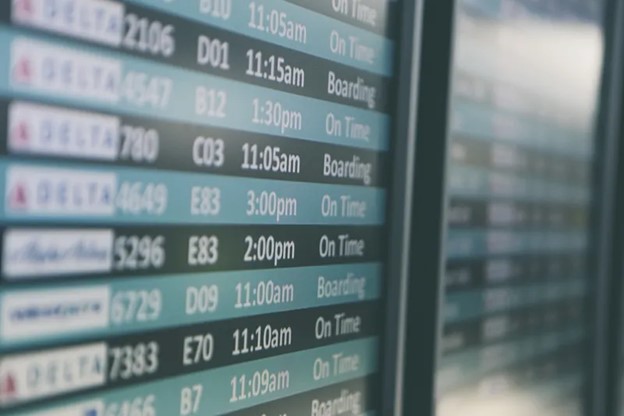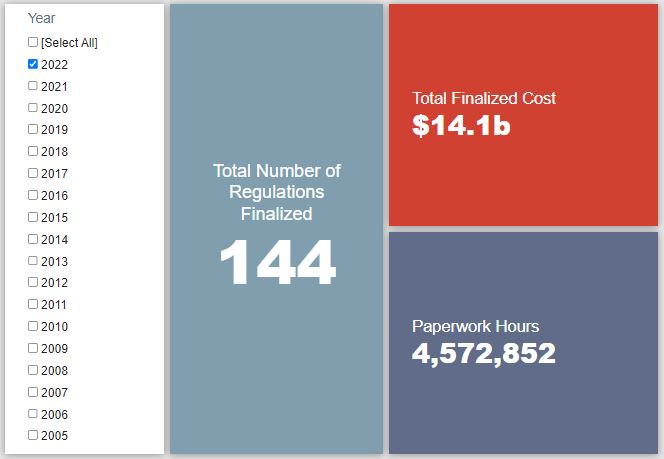Week in Regulation
August 8, 2022
A Hot Start to August
The temperature and humidity weren’t the only things that spiked upward in Washington, D.C. last week – regulatory costs did, as well. There were a dozen rulemakings with some quantifiable economic impact. A proposed rule on nondiscrimination protections in health care and a series of rulemakings from the Department of Transportation (DOT) were among the stand-out items. Across all rulemakings, agencies published $2.9 billion in total net costs and added 1.4 million annual paperwork burden hours.
REGULATORY TOPLINES
- Proposed Rules: 32
- Final Rules: 48
- 2022 Total Pages: 48,006
- 2022 Final Rule Costs: $14.1 billion
- 2022 Proposed Rule Costs: $86.9 billion
NOTABLE REGULATORY ACTIONS
The most consequential rulemaking of the week was the Department of Health and Human Services (HHS) proposed rule on “Nondiscrimination in Health Programs and Activities.” The proposal is the latest iteration of a long-winding thread of rulemaking regarding the prohibition of “discrimination on the basis of race, color, national origin, sex, age, or disability in certain health programs and activities” found in Section 1557 of the Affordable Care Act that has volleyed across the past two administrations. The proposed rule is, broadly, a reinstatement of a 2016 Obama Administration rule on the matter that the Trump Administration had largely rescinded in a 2020 rule.
On top of reviving the Obama-era version, the proposal also seeks to establish broader protections for health issues related to sexual orientation and gender identity in light of the Supreme Court’s expansion of the legal definition of sex discrimination to cover such categories in its Bostock decision. HHS expects the primary areas of costs for covered entities to include training employees on the details of 1557 protections, updating administrative procedures and materials to reflect these new protections, and providing more expansive coverage for care related to individuals undergoing gender transition. The agency estimates that these costs would add up to a total of $2.3 billion, or roughly $560 million on an annualized basis.
The most notable final rule of the week came from DOT in its rule regarding “National Standards for Traffic Control Devices; the Manual on Uniform Traffic Control Devices for Streets and Highways; Maintaining Pavement Marking Retroreflectivity.” The rule updates “the Manual on Uniform Traffic Control Devices (MUTCD) to provide standards, guidance, options, and supporting information relating to maintaining minimum levels of retroreflectivity for pavement markings.” Such standards have apparently gone without an update since a 2007 rule on the matter. DOT expects covered state and local transportation authorities to incur $296 million (or $27.9 million on an annualized basis) in costs over a 20-year period as they update both their general road maintenance practices going forward and address markings that require additional retroreflectivity.
TRACKING THE ADMINISTRATIONS
As we have already seen from executive orders and memos, the Biden Administration will surely provide plenty of contrasts with the Trump Administration on the regulatory front. And while there is a general expectation that the current administration will seek to broadly restore Obama-esque regulatory actions, there will also be areas where it charts its own course. Since the AAF RegRodeo data extend back to 2005, it is possible to provide weekly updates on how the top-level trends of President Biden’s regulatory record track with those of his two most recent predecessors. The following table provides the cumulative totals of final rules containing some quantified economic impact from each administration through this point in their respective terms.
![]()
The Biden Administration saw a noticeable uptick in its final rule tallies, with $390 million in increased costs and roughly 472,000 additional hours of paperwork. The DOT rule on pavement markings discussed above provided the bulk of that cost shift while a Medicare payment rule accounted for the paperwork. In terms of the other administrations, there was (somewhat surprisingly) little to report from the Obama Administration, but there was a continued downward shift from the Trump Administration. Driven primarily by a deregulatory measure regarding coal ash standards, Trump-era costs dropped by roughly $600 million. With this decrease, the net-cost total under Trump as of August 2018 stands at roughly 0.1 percent of the Biden Administration’s total thus far.
THIS WEEK’S REGULATORY PICTURE
By Mariam Chachava, Regulatory Policy Intern
On August 3, 2022, DOT released a Notice of Proposed Rule Making (NPRM) regarding “Airline Tickets and Consumer Protection.” The rule is intended to enhance the protection of passengers’ rights and reduce unfair business practices by establishing further requirements for airlines in how they compensate passengers for canceled flights, especially in light of health-related cancellations or delays.

Source: “Airport departures timetable” by Matthew Smith
DOT argues that comprehensive restrictions imposed during the COVID-19 pandemic raised fairness concerns regarding flight cancellation policies. While airlines typically offered compensation in the form of travel vouchers or credits with a specific expiration date for flights canceled for pandemic-related reasons, customers were often unable to use them. Most commonly, customers faced frequent flight restrictions or simply did not want to fly with the risk of COVID-19 still present. To that end, this NPRM focuses on updating the definitions related to flight reimbursement claims as well as providing passengers more favorable reimbursement options.
First, the NPRM requires companies to deliver a prompt refund (within seven days in the case of credit card purchase and within 20 days in the case of any other form of payment) to customers if their flight is canceled or there are significant changes in the itinerary. To avoid confusion and differing interpretations of the rule, DOT explicitly defines the cancellation of a flight in the following way: “Flight that was published in a carrier’s Computer Reservation System at the time of the ticket sale but was not operated by the carrier.” The “significant changes in the flight” will include any of the following changes in the itinerary: (i) departure or arrival time by at least three hours for domestic flights (and six hours and more for international flights); (ii) departure or arrival airports; (iii) number of connection flights; and (iv) type of the aircraft flown if this implies a significant downgrade of the quality of the travel.
DOT also argues that it is an unfair practice to not provide reimbursement to those who have purchased non-refundable tickets in case of a canceled flight due to health concerns, including special rules for a “public health emergency [PHE].” To protect passengers’ rights to flight in a safe environment, DOT proposes to require airlines provide at least some non-expiring reimbursement (such as a voucher) for flights canceled due to health concerns. Notably, however, during a declared PHE, airlines that “received significant financial assistance from the government as a result of a [PHE]” would need to reimburse passengers with direct refunds rather than simply a voucher or coupon.
Consumers can request compensation for their forgone flight if: (i) government prohibits travel due to the increased risk of the spread of communicable diseases; (ii) there is a recommendation from the relevant public health entity (i.e., World Health Organization, Centers for Disease Control and Prevention and comparable entities in other countries) to avoid flights; (iii) relevant public health authorities declare a health emergency to prevent spread of the communicable diseases. Consumers will have to provide corresponding documentation from a doctor that they are vulnerable to certain communicable diseases, and that it would impose significant risk to their health to take a flight during a PHE.
DOT expects that the benefits associated with these amendments will depend highly on unpredictable future events, such as the number of canceled flights and the probability of a PHE. In case of an emergency declaration, the proposed regulation will have a significant impact on the air carriers and ticket agencies. DOT expects minimal impact from the regulation on the business practices of the airline companies in the absence of a PHE, however.
TOTAL BURDENS
Since January 1, the federal government has published $101 billion in total net costs (with $14.1 billion in new costs from finalized rules) and 80.5 million hours of net annual paperwork burden increases (with 4.6 million hours in increases from final rules).











